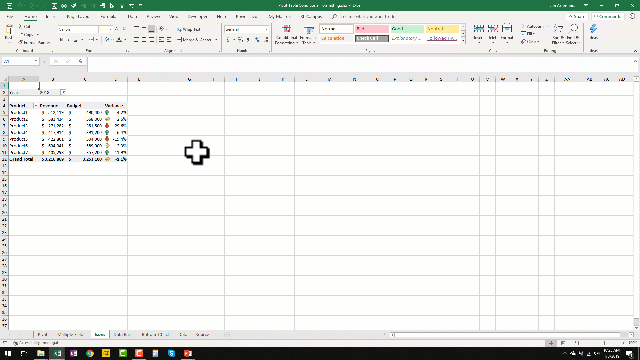

- #SPLIT SCREEN BETWEEN TABS IN EXCEL FOR MAC 2016 HOW TO#
- #SPLIT SCREEN BETWEEN TABS IN EXCEL FOR MAC 2016 CODE#
When you have the code to repeat itself, though, it can do longer and more complex automation tasks in seconds.
#SPLIT SCREEN BETWEEN TABS IN EXCEL FOR MAC 2016 HOW TO#
I just showed you how to take a simple action (copying and pasting) and attach it to a button, so you can do it with a mouse click. Additionally, you can combine copying and pasting in VBA with some other cool code to do even more in your spreadsheet automatically. But when you copy and paste the same cells several times a day, a button that does it for you can save a bunch of time. Therefore, you need these lines to paste your cells with VBA: Range("Insert where you want to paste").Select ActiveSheet.Pasteįor example, here's the code you'd need to cut the range A:C and paste it into D1:Ĭopying, cutting, and pasting are simple actions that can be done manually without breaking a sweat. That means that you can’t paste values only, or formatting only. When cutting, you can’t use the ‘PasteSpecial’ command. Here’s the code: Range("Insert range here").Cut Cutting is quite easy and follows the exact same logic as copying. If you want to relocate your data instead of copying it, you need to cut it. Range("The cell/area where you want to paste").Pastespecial xlPasteValues ← only pastes values Range("The cell/area where you want to paste").Pastespecial ← pastes as normal (formulas and formatting) 99% of the time, you’ll need one of these two lines of code: Pasting can be done in different ways depending on what you want to paste.
/article-new/2016/01/Word-2016-Mac.jpg)
Tip: Remember to enter these lines manually when you’re not using the macro recorder. Excel makes that easy, too: When you type in "Sub" followed by the macro name in the beginning of the code, the End sub is automatically inserted at the bottom line. Remember when you recorded a macro before? The macro had Sub Nameofmacro() and End sub at the top and bottom line of the code. Range("A:C").Copy ← copies column A through C Just insert this code into the VBA Editor: Range("Insert range here").Copy. First, let's look at the code we need: Copying Cells with VBAĬopying in VBA is quite easy. Let’s try to copy all the data in columns A through C into D through F using VBA. This is a sample employee database with the names, departments, and salaries of some employees. Open the project file you downloaded earlier and make sure the "Copy, cut, and paste" sheet is selected. Let's see how to code a macro that will copy data and move it around in a spreadsheet. What if your spreadsheet could do that for you? With a macro, it could. Now, let’s get started with actual coding!Ĭopying and pasting is the simplest way to move data around, but it's still tedious. When you’re done, go to the "View" tab, click the tiny arrow below the "Record Macro" button again and select "Stop recording". Perform the actions in your spreadsheet you want to be turned into a macro. Type in the name of your macro and click "OK" to start the recording. Go to the "View" tab of the ribbon and click the tiny arrow below the "Macros" button. But it's still a handy way to get started. You'll still need to type or edit code manually sometimes. There are limitations to this, so you can't automate every task or become an expert in automation by only recording. When you’re done, tell Excel to stop recording and you can use this new macro to repeat the actions you just performed again and again.

Then you perform the tasks you want to be translated into VBA code. When you record a macro, you tell Excel to start the recording. Later on, it serves as handy storage for code that you don’t need to memorize. Recording a macro is a good way of getting to know the basics of VBA. The main focus of this article is on the former, but recording a macro is so simple and handy, it's worth exploring too. There are two ways to make a macro: code it or record it.


 0 kommentar(er)
0 kommentar(er)
